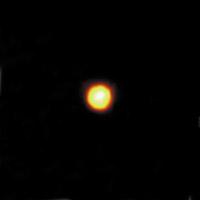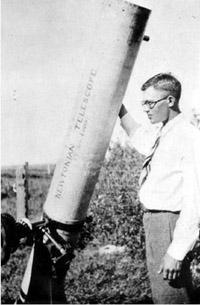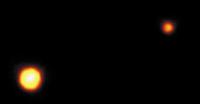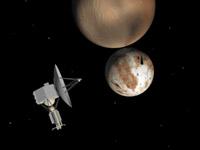Pluto: 9 questions about small light

It seems the question of a television contest. How many planets are there in our solar system? Asking a question to any of the streets and surely the answer would be “nine”. In addition, without request, in order of sunrise, it would issue a complete list. Mercury, Venus, Earth, Mars, Jupiter, Saturn, Uranus, Neptune and Pluto. Very good. But let's analyze the list more calmly.
The following question may be: Which of them is bigger and which one smaller? The answer to the middle of the question is simple for a majority and the other half is not very difficult for those who have worked on the cushion of astronomy. Jupiter is the largest. The smallest is Pluto. Discover the mysterious planet. It is small and far away. No wonder man only discovered it 70 years ago. The search was very complex. And it is still more difficult to find out that there are new planets.
The farthest planet man knew until the telescope was invented was Saturn. Even with the invented telescope there were no great reasons to look for new planets. They would look if they existed. In 1781 the British astronomer William Herschel saw something moving slowly while observing the stars. Uranus was the first "found" planet. The study of Uranus's orbit led to the discovery of Neptune. In 1846, the calculations of the British mathematician John Couch Adams allowed to identify Neptune.
Image of the photographer
After measuring the orbits of Uranus and Neptune, XX. In the early 20th century astronomer Percival Lowell announced that another planet was missing without which the orbits of the other two could not appear. The search was done by photographs. With a large telescope hundreds of photographs were taken from the area of space planned in Pluto. In 1930 Clyde W. It was discovered by astronomer Tombaugh. The light points that did not undergo changes in the photos should be stars. Closer, the movements of many asteroids stood out. Tombaugh also saw a small point moving slowly between stars and asteroids: Pluto.

Pluto did not have the characteristics of other planets. The four planets moving near the Sun are small but not so small. The lowest of the four is Mercury, and yet Pluto's radius is less than half of it. In addition, Mercury, Venus, Earth and Mars have metallic core and Pluto of rock. On the other hand, it is located "next" to the following four planets. But Jupiter, Saturn, Uranus and Neptune are gaseous giants. Its density is very low. The density of the plutonas is high and not similar. Continuing with the size, not only Mercury but four satellites of Jupiter, one of Saturn, another of Neptune and our Moon are also larger than Pluto. By placing Pluto in the place of our Moon we would see at night a sphere somewhat larger than half the Moon.
As is often said, appearance is not all. Pluto is also rare for other features. We can dismiss the bad question. Where to look for Pluto? For anyone who is not an astronomer it is almost impossible to determine their location. Don't worry. This was also true for early astronomers. Lowell, based on the disturbance of Neptune's orbit, calculated the position of "planet X" (later called Pluto). Astronomer William Pickering also performed calculations. Lowell made a good prediction of the location but not the mass.
Pickering, on the contrary. From 1905 Lowell devoted himself to portraying this space zone, but he did not see Pluto's footprint. He died in November 1916 tired and totally frustrated. Tombaugh continued his work and found Pluto in 1930. But this discovery is more surprising, in 1993 NASA's E. Because astronomer Miles Standish showed that there is no disturbance in Neptune's orbit. Pluto currently has no significant influence on the movement of Neptune.
Pluto's orbit is also very curious. The orbits of eight other planets are almost on the same plane. This effect is a direct consequence of the rotation and gravity of the Sun. In the plane of Pluto's orbit it forms an angle of 17 degrees with it, which, being such a small mass, means that the effect of the rotation of the Sun has not been entirely picked up. Its orbit is very elliptical. When it is on the Perihelion, that is, at the closest point to the Sun, Neptune is the furthest planet.
Sometimes yes, sometimes no

This is another curious feature, which is the eccentric answer to the next question. Does Pluto have atmosphere? All answers to the above questions are data. Possible. On all other planets it is clear that they have atmosphere or not. Mercury no, Venus yes, Earth yes, Mars more or less, etc. Pluto, however, is about 4.4 billion kilometers away when "approaching" the Sun. It then has a thin and light atmosphere composed of methane, carbon dioxide, nitrogen and urezas. On the contrary, when it moves away from the Sun it reaches 7.500 million kilometers, as happened in February 1999. At that distance all molecules of the atmosphere have been frozen and one cannot speak of the atmosphere.
Pluto's discovery was a major event in the United States. Lowell and Tombaugh were Americans and worked in Arizona. It was the beginning of the golden years of astronomy in the United States. One of the consequences of the attention he woke up in the 1930s came out of the pencil of cartoonist Walt Disney. He invented a dog named Pluto and put the new character in the movies. However, according to some writers, when the mass of the planet was seen to be much smaller than they thought at first, Pluto's charism was reduced.
The simple calculations made immediately after knowing Pluto announced that their mass was 11 times greater than that of Earth. As the observations were made, the estimated mass of the planet was reduced. Alex Dessler of the University of Arizona studied calculations over time. If so, by 1990 Pluto disappeared. In the end they saw that it was a very small object. F
Fundamentals of Sidereal Philosophy
What was said so far, with a very slow rotation and taking into account many other features, one may ask... Is the planet Pluto? For today's people, and also for astronomers, it will always be the planet, the last of the solar system. But it is questioned. Astronomer Brian Marsden of the International Astronomical Union (IAU) proposed the designation of a "secondary planet" and a "planet." He says that if Pluto were found today, he would be considered secondary. Marsden may not be wrong.
However, the UAE staff, who designate and classify the objects of space, decided to keep the previous one. It is the planet Pluto. IAU uses the term planet minor as an almost asteroid synonym, and it is clear that Pluto is not an asteroid. In addition, if Pluto is not considered a planet, we should also study the classification of other planets. For example, Mercury has no atmosphere, no satellite... is it planet? Mars is a big round asteroid… is it the planet? Jupiter behaves like a star... is the planet?

These arguments lead directly to the next question. What is the planet? This is one of the easy answers on the street, but astronomers do not give a precise definition. It can be said that there are two basic rules to define the planets. The first is that you have to complete an orbit around a star. The second, which has to have enough mass to have a spherical appearance due to gravity. Pluto, at least, meets both conditions. However, the debate is not over. It may not be just these two rules. Things are not black or white.
In addition, recently planets that revolve around two stars have been detected. These do not meet the first rule and yet no one has said that the planets are not. On the other hand, objects are known that are something between stars and planets. As astronomy develops, as in any other field of science, limits of knowledge begin, and ancient terminologies and definitions cannot determine all answers.
But let us return to Pluto. Marc W of the Lowell Observatory. Astronomer Buie explains things differently. According to his proposal there are three types of planets. The first type, "like Earth," includes Mercury, Venus, Earth, and Mars. The second, "gas giants", Jupiter Saturn, Uranus and Neptune. Pluto is a third type that could be called "ice planets."
Friends of the flight
In the case of Pluto, at least in this article we will maintain the current street tradition and consider it as a planet. And to return to the topic, we can ask a new and simple question. As with other planets, it would be legal to have satellites around Pluto. Does Pluto have any satellite? Anyone who has immersed himself in the astronomy treaties or at least navigated in the dissemination writings will immediately answer yes.
In 1978 James W. Christy and Robert S. American astronomers Harrington were taking pictures of Pluto to improve their orbit model. In the photos he saw Christy with a bulging Pluto. The photos in the files also looked bulky but in different locations. After confirming that the mistakes of the photos or the stars on the back were not, Christy announced that it was Pluto's satellite and called him Karonte. Harrington proved in the coming years the discovery of Christy.
The satellite Charon radio is about half the Pluto and the distance between the two is 19,600 kilometers. As on many occasions, for the common man are only numbers. But the meaning of numbers is representative. It can be said that it is a system of two planets, since in the solar system no other satellite is known as big compared to your planet. The Lurra-Ilargia system is the following in this list and has always been cited as an example of a singular case. As with the Earth and the Moon, Pluto and Karonte always show the same difference. In other words, the rotation period coincides with the turning period around Pluto. These special couples look at each other as if they were dancing. Pluto's satellite also had to be a bit weird, of course.

So close to Pluto it is difficult to analyze Karonte. However, astronomer Michael Brown and his colleagues at the California Institute of Technology have managed to conduct an analysis of Karonte's composition with tools at the top of the Mauna Kea volcano. The Charon is formed by ice, but the ice found does not exist at -225ºC and is the estimated temperature of the planet in the perihelion of Pluto. This means that Pluto and Karonte are warmer than previously thought. Reason, once again, is surrounded by mystery. Perhaps the Karonte ice has undergone a process of vulcanization, perhaps it has recently collided with another object... who knows.
And further away… what?
Being the last planet can also cause skeptics to crave. Does the solar system end with Pluto? Perhaps we do not know the next planet because it is far away, because it is very small, because it moves in a totally capricious orbit or because it has not been properly sought. Astronomy fans have a quick response in this case. In 1992, the first small ice object announced was detected, about two hundred kilometers in diameter. Then another... In March 1999 the list consisted of 130 copies. Dutch astronomer Gerard Pieter Kuiper thought the solar system did not end suddenly. Therefore, it is admitted that outside it is surrounded by these objects of ice. It is currently known as "The Kuiper Belt".
Knowing this, you can reask the fifth question. Again? Yes, but somewhat altered. Like this: How does the duo Pluton-Karonte arise? It is an unanswered question for the moment. There are many hypotheses and new hypotheses appear and old ones are discarded as knowledge expands. In his day it was proposed that Pluto is an ancient satellite of Neptune. A shock would take you on your way, but without altering the rotation period. This would explain why Pluto has the type of rotation of the satellites. Furthermore, Neptune also keeps many mysteries. For example, Triton, Neptune's largest moon, has the whole aspect of being an ancient planet that at some point Neptune was going to catch.
Today, however, a new hypothesis has been opened among astronomers. Pluto and Karonte are two giant specimens of the Kuiper belt. How they increased so much, how they got together and how they got the current orbit and the situation is not known. What can you say? That there is something to investigate! News That does not remove Pluto's category to the "planet".
By 2004 NASA prepares a probe that will travel to the area of Pluto and Karonte. With what this probe sees, more questions will be generated and the current ones may be answered. Meanwhile, those who are fascinated by the mystery of the last planet would love the acidic photo of Pluto, right?





